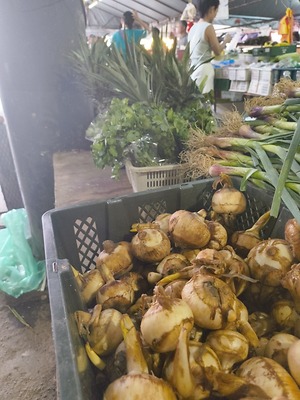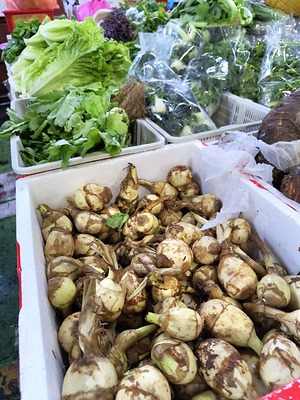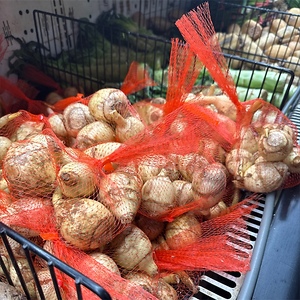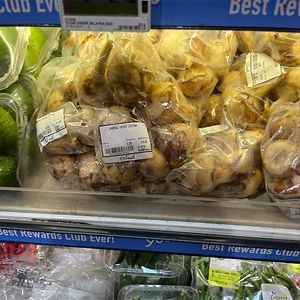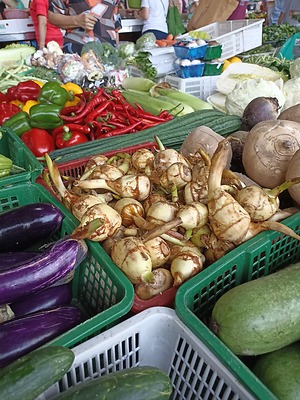


Chi Gu
Estimated Inventory, lb : 0
Description/Taste
Chi Gu is a small to medium-sized bulb, averaging 4 to 6 centimeters in diameter and 5 to 8 centimeters in length, and has a round, ovoid, to slightly flattened, oblate shape, sometimes sold with or without a curved sprout at the top, depending on the market. The bulbs are smooth, often covered in a brown to ivory protective film, and appear in shades of blue-grey, blue, tan, to ivory with some rough brown patches. There is also a longitudinal line typically seen around the top center of the bulb. Underneath the tough, fibrous skin, the white flesh is dense, starchy, firm, and solid, with a crisp and crunchy consistency. Look for bulbs that are crack free, plump, and fresh without any signs of discoloration. Cracks in the flesh will cause dirt to penetrate the bulb's interior, resulting in a loss of available edible flesh. Chi Gu must be peeled and cooked for consumption, developing a soft consistency reminiscent of a potato with a light crunch like a water chestnut. The sprout and tuber are both edible and have a mild, bland, earthy, and nutty flavor with subtle bitterness and astringency.
Seasons/Availability
Chi Gu is available in the mid-winter.
Current Facts
Chi Gu, botanically classified as Sagittaria sagittifolia, is the starchy tuber of an aquatic, leafy perennial belonging to the Alismataceae family. The bulbs are collected from plants commonly found in regions with flowing water and are a seasonal item historically sold through fresh markets in Asia as a medicinal and culinary ingredient. Chi Gu is also spelled Ci Gu, Chigu, and Cigu in China and is the Mandarin name for the bulbs, while in Cantonese, they are known as Tse Goo, Khoai in Vietnam, Kuwai in Japan, and Chinese Arrowhead and Arrowhead in English. Chi Gu is also commercially produced in East Asia, primarily in China and Japan, and there are several varieties with varying tuber colors, sizes, and flavors. In the modern day, Chi Gu is a rare, hand-harvested item sold seasonally in Asian markets, typically around the Lunar New Year. The bulbs are prepared similarly to a potato and provide a neutral starchiness to savory and sweet culinary preparations.
Nutritional Value
Chi Gu is a source of fiber to regulate the digestive tract, potassium to balance fluid levels within the body, and calcium to build strong bones and teeth. The tubers also provide some vitamin C to strengthen the immune system while reducing inflammation, zinc to heal damaged tissues, iron to develop the protein hemoglobin for oxygen transport through the bloodstream, and other nutrients, including phosphorus, niacin, thiamine, and riboflavin. In Traditional Chinese Medicine, Chi Gu is simmered or steamed with honey and ginger as a warming decoction. The bulbs are thought to nourish qi, reduce coughs, moisturize the lungs, and detox the body.
Applications
Chi Gu has a neutral, starchy, and subtly astringent flavor suited for cooked preparations. The tubers must be peeled and cooked before consumption, as the skin is said to have a bitter taste. Consumers also believe the skin absorbs heavy metals from its growing environment and should be peeled to remove these from culinary dishes. Chi Gu should be thoroughly washed to remove dirt, and the stem should be left on the peeled bulbs to use as a handle for slicing. Once the bulbs are sliced, the stem can be discarded. Depending on how Chi Gu is cut, the flesh will develop various textures. The thicker the pieces, the more starchy and potato-like the flesh will be. It is recommended to thinly slice the bulbs in dishes to create a crisper texture. Chi Gu can be incorporated into braised, stir-fried, or boiled preparations and the bulbs are most famous for their use in pork dishes. Pork dishes are said to release oils while cooking, and these oils are absorbed into the bulb's flesh, reducing its astringency. Chi Gu is also sliced into soups and is a common ingredient in hot pot, stir-fried with vegetables, dry roasted with tea leaves, or sliced thin and fried into chips. In Japan, the bulbs are simmered in a mixture of sake, soy sauce, and mirin in nimono, a dish served with other vegetables, seafood, or tofu. In China, Chi Gu was notably used in a roasted pork dish once declared by Emperor Pu Yi of the late Qing Dynasty as his favorite imperial meal. Chi Gu pairs well with lotus root, carrots, mushrooms, daikon radish, ginger, dark leafy greens, seafood, and meats such as beef, pork, and poultry. Whole, unpeeled Chi Gu will keep for one week when stored loosely wrapped in an open plastic bag in the refrigerator.
Ethnic/Cultural Info
Chi Gu is traditionally available in the months surrounding the Lunar New Year. The bulbs are popularly planted in pots and allowed to sprout in home kitchens as decorations for New Year celebrations. The arrow-shaped green leaves symbolize the coming spring and provide life to the home. The name Chi Gu in Chinese also roughly translates to mean benevolence, and the upward growth of the leaves parallels the hope for forward movement in the year to come. In China and Malaysia, Chi Gu is customarily cooked in New Year dishes, especially in braised or stir-fried pork meals, and these dishes are the most established ways of preparing the bulbs. In modern preparations, Chi Gu is being reinvented into a fried chip. Sliced and fried Chi Gu is similar in appearance to small potato chips and has a pleasant, crunchy consistency. The chips are typically made by hand in home kitchens and are placed as a snack food during Lunar New Year gatherings. The modernization of Chi Gu preparations has allowed the bulbs to find a new space in evolving culinary markets. In Japan, Chi Gu is known as Kuwai and is served as an ingredient for Osechi Ryori, Japanese New Year’s food. The protruding sprouts are a symbol of new growth and development, and the tubers are believed to bring good fortune and career success in the coming year if consumed at the start of the new year. Osechi Ryori is typically served in lacquered boxes filled with auspicious foods that bring specific wishes such as health, prosperity, luck, and fertility. One of the unique ways Kuwai is prepared in Osechi Ryori is to peel and cut the tubers into hexagons or octagons. This shape is meant to resemble a turtle’s shell, and the angular, geometric pattern symbolizes longevity.
Geography/History
Chi Gu is a species of Sagittaria sagittifolia native to tropical and temperature regions of Asia and Europe. Over 20 species of Sagittaria are found in different regions worldwide, and the herbaceous aquatic plant has been growing wild since ancient times. The plants were spread throughout Southern China in the early ages and were introduced to Japan sometime durian the Heian Era, 794 to 1185 CE. In the Song Dynasty in China, 960 to 1279 CE, Chi Gu increased in commercial cultivation in Southern China due to migrating peoples fleeing wars in the north. The starchy bulbs were utilized as a filling ingredient for large populations, and the plant's short life cycle allowed farmers to grow the plants in paddy fields. By the 16th century, Chi Gu was developed and domesticated in China to produce larger, fleshier bulbs. In Japan, Chi Gu was commercially cultivated beginning in the Edo Period, from 1603 to 1868 CE and was planted in paddy fields covered in a few inches of flowing water. Today Chi Gu can be found growing wild and commercially produced in slow-moving marshes, ponds, canals, rivers, and lakes, and the species is primarily cultivated in the provinces south of the Yangtze River in China and in Ishikawa, Hiroshima, and Saitama Prefectures of Japan. Outside of China and Japan, Chi Gu is grown on a small scale, mostly in home gardens, or it is imported from China to Korea and parts of Malaysia. When in season, Chi Gu is sold through local fresh markets, select distributors, and retailers in Asia.
Recipe Ideas
Recipes that include Chi Gu. One
| Hunger Hunger |
|
Chi Gu Chips |
| Hunger Hunger |
|
Chi Gu And Pork with Nam Yue |
| Cuisine Paradise |
|
Deep Fried Arrowhead (Chi Gu) Chips |



